
The short circuit of Grambois
"Arriving at Grambois for the first time, I suddenly let myself be surprised by the sight of this village perched on a spur. Taking a picture was a must! Then immediately I went exploring the cobbled streets, trying to discover the history of this authentic village. At its peak, the beautiful view of the Eze Valley, the plain of the Pays d'Aigues and neighboring villages, finally seduced me." says Séverine Besson, Task Officer for the Valuation of assets at the south side Luberon Tourist Office.
15 points of interest

Verger villageois de Grambois - ©Benjamin Delcastillo - OTI Luberon Sud Tourisme  Flora
FloraConservatory orchard
The village of Grambois orchard is set at the foot of the village, a scenic grounds with a restored loft. It is maintained jointly by the municipality, and Gramboisiens Gramboisiennes and the Regional Park of Luberon. This orchard helps perpetuate the culture of old varieties of fruit and gather a collection of 91 traditional varieties of the Luberon and Provence. A beautiful fruit heritage conservation!
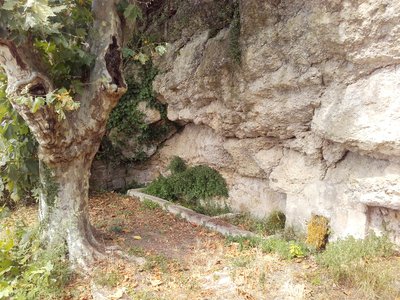
La source de Fontsausse et ses bassins - ©Eric Garnier - PNR Luberon  Water and rivers
Water and riversSource Fontsausse
Under the remarkable ivy you can watch the fountain Fontsausse. It is powered by a source, from which flows a small jet of water. The basin that receives water is converted into laundry and the overflow discharges into a pool on the side. It then feeds a vegetable garden. "Fontsausse" could mean the fountain willow, which grows in wet field, but also the "saulcées" sheep pens made from soft wood barriers crossed.

Amandier recouvert de lierre - ©Eric Garnier - PNR Luberon  Flora
FloraIvy, parasitic plant?
Qualified pest harm, ivy uses small aerial roots but no fee sap of the tree, unlike mistletoe. If the tree is healthy coexistence between the two plants is going well, they make mutual services. Ivy protects her weatherproof support shaft and can colonize every trunk and branch available to develop. Its presence can be a threat only if the tree is weakened colonized, ivy then taking over.

Cime du grand cyprès - ©Eric Garnier - PNR Luberon  Flora
FloraThe cypress, a southern figure!
Although originating from Asia, cypress and slim silhouette are true markers of the Mediterranean landscape. Despite its slow growth, it can reach up to 30 meters high. This conifer is resistant to wind and sea spray and lifetime can exceed 500 years. According to the Provencal tradition, the presence of three cypresses at the entrance of a house is a symbol of hospitality.
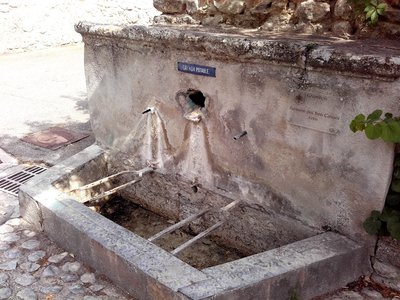
Fontaine des trois canons - ©Eric Garnier - PNR Luberon  Patrimony and history
Patrimony and historyFountain of the three guns
This fountain dating from the thirteenth century. is supplied by a water mine gallery dug horizontally to capture seepage. This technique of "mine water" dates from ancient times and was used in particularly dry areas where resurgent water were almost absent.

Rempart de Grambois - ©Alain Hocquel - VPA  Patrimony and history
Patrimony and historythe rampart
Dating from 1377, the wall consists of a rubble wall masonry, thick two meters. It overlooks the town square that bears its name. His face is pierced with eight narrow loopholes. During the sixteenth century wars of religion. Many changes were made to the ramparts of Grambois. However, these precautions did not prevent the Savoy army to seize and put in Grambois bag in December 1590.
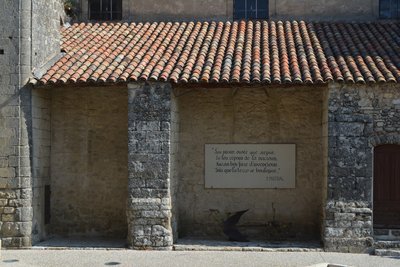
Porche de l'église et la citation de Frédéric Mistral - ©Benjamin Delcastillo - OTI Luberon Sud Tourisme  Patrimony and history
Patrimony and historyFrédéric Mistral and Provencal
On the side of the church, a quote from Frédéric Mistral extracted from "Lis Oulivado, the song of the peasants": "The peasant, in all countries, is the nation's media. inventions we will make beautiful, must stirs the earth. " The author, Nobel Prize for Literature in 1904 for his work Mirèio, is a strong supporter of the langue d'oc. He contributed to its rebirth with five other poets creating in 1854 the Félibrige regionalist association aiming to promote the language.
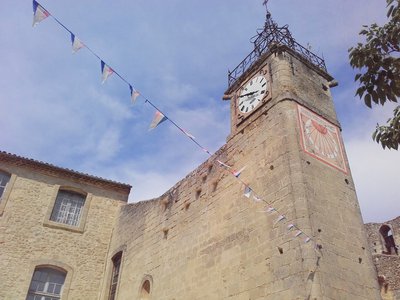
Clocher, campanile et cadran solaire - ©Eric Garnier - PNR Luberon  Patrimony and history
Patrimony and historyThe Notre Dame de Beauvoir
This Romanesque church, founded in the eleventh century. is classified a historical monument. Inside, the columns capitals are rare vestiges of Romanesque sculpture from the XI-XII century. in Provence. The polyptych (set of painted panels) of St. John the Baptist dating from 1519, is classified. This building has two towers: a bell wall 1584 and an elegant tower for the clock from the eighteenth century., crowned by a wrought iron campanile in the nineteenth century.

Star fontaine de ''La gloire de mon père'' - Séverine Besson - OT Luberon Côté Sud  Patrimony and history
Patrimony and historyGrambois, movie set
Perhaps you recognize some familiar scenery while walking in the village of Grambois ... Indeed, the village was used for film sets. Yves Robert shot a few scenes of his film "The Castle of my mother" and "The Glory of my father" in 1989. The Fountain Square was used for some scenes in which the game of bowls and the return of the famous hunting partridges. Since it is colloquially renamed "Fountain Bartavelles".

Château de Grambois - ©Eric Garnier - PNR Luberon  Patrimony and history
Patrimony and historyThe Grambois castle
The castle, or rather the former mansion dates from the sixteenth century. In 1879, the house was divided into two parts: one is inhabited (private property) and the other is the presbytery. Castle received some prestigious guests, as Madame de Sevigne, or Mirabeau. The latter took pleasure indeed to go riding in the lounge on the ground floor through the window. The castle houses the town hall today.
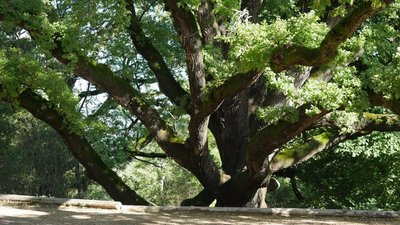
Chêne remarquable de Grambois - ©OTI Luberon Sud Tourisme  Flora
Floraremarkable oak
This very large majestic oak is one of the most remarkable of the Luberon. It spreads three enormous scaffold by from 10 to 13 m long, the lowest having a circumference of 2.75 m in the trunk. To spread and cracked bark beautiful harbor, it would be a survivor of the oak grove, destroyed in the late eighteenth century., Owned by the family Roquesante who held the lordship of Grambois from 1669 to 1790.
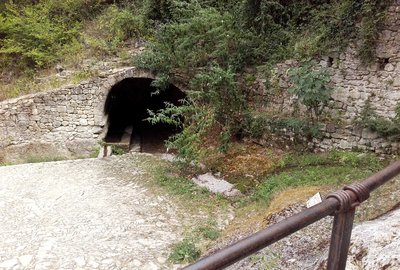
Entrée de la source de Fontvérance - ©Eric Garnier - PNR Luberon  Water and rivers
Water and riversSource Fontvérane
A small road built in 2012 down to the source Fontvérane, always living place for Gramboisiens old face the problem of water. The fountain Fontvérane, whose initial expertise raised fears weakness of the vault, was cleared of all trees recently. Work has been carried out, the result is close to what the fountain at the time of its construction.
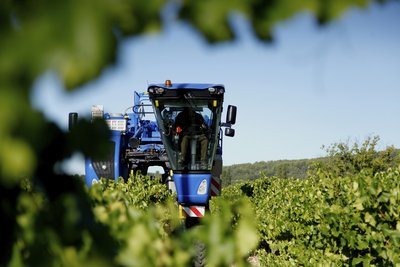
Vendange - ©Olivier Messel - Zoom Allures  Produits du terroir
Produits du terroirWine cooperative
On the other side stands the back of the cellar, created in 1924 by 12 winegrowers. Born in 1988, the AOC Luberon is on Grambois, a designation for vineyards lying at an altitude of between 200 and 450 m. The vineyard of Coteaux Grambois at the foot of the Luberon, met 96 winemakers of 586 hectares of vineyards, cultivated in the Agri Confiance approach for part of them. Some vintages are "Values Park" brand quality Luberon Park.??
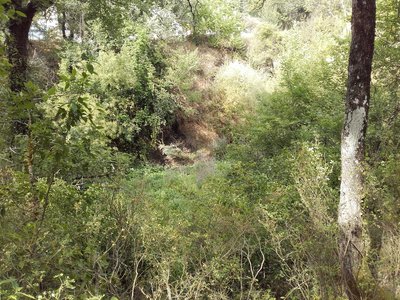
Bords de l'Eze - ©Eric Garnier - PNR Luberon  Flora
FloraEdges of Eze, poplar, willow
Formerly the edge of watercourses was maintained by necessity. The vegetation was a resource for heating and livestock. The evolution of practices has reduced the interest that was carried to streams. Local residents have gradually freed from this resource, maintenance is not carried out and the banks suffer from a rural abandonment. Numerous dead trees are now home to many insects.

Restanque - ©Eric Garnier - PNR Luberon  Patrimony and history
Patrimony and historyRestanques
The word terraced, Latin and Provençal Restanca Restanco means dam, dike or restraint. Originally built in the bed of a stream or valat (valley floor), these dry stone walls built without mortar allowed to trap silt while passing water. The terraced term applies by extension to the terraced fields. This ingenious construction system that has become widespread in Provence in the eighteenth century., Is also an excellent thermal reserve.
Description
Head towards the bottom of the car park and take the gravel road to the left about twenty meters. Go into the driveway to the right and reach the fifth dovecote.
1- Take a left and head up the olive tree paths and reach the road (D122). Cross it and climb the Chemin de Fontsausse. Pass a curve around the spring at the foot of the rock and continue. Descend to the right the Rue de Ribas for 100m and climb the steep paved path to the left of Chemin des Pasquiers. On top of the hill, continue straight to the fountain with the three barrels.
2- Turn left, taking the stairs and come out on the Place des Remparts. Cross it then continue left to the town hall square. After the square, turn right and go down the paved street of Rue du Château. Continue to the right and cross the winding descent and pass the Porte de Fontvérane. Go up to the right the Rue de la Ferrage.
3- Before the calvary (cross) exit left the main street. 100m lower, hurtle down to the left the little staircase and then go left under a remarkable oak. Continue the path, go down a final series of steps and lead right to the Fontvérane source. Go down the wide path to the left. Leave behind the right trail (marked in green) and continue straight on the slope (GR markings) on about 200m.
4- In a right turn, take a left along a path overhanging the left bank of the Eze. Further down, go along an old meadow and climb slightly to the left (4 steps). Then continue into the undergrowth. Cross the road (D122) to regain the car park of the starting point
- Departure : Car park of the Moulin du Pas bridge, Grambois
- Arrival : Car park of the Moulin du Pas bridge, Grambois
- Towns crossed : Grambois
Forecast
Altimetric profile
Recommandations
Be careful when crossing the road after point 1, then at the end of the walk when heading back to the parking lot.
Information desks
House of the Luberon Regional Nature Park
60, place Jean Jaurès, 84400 Apt
In the heart the old town centre of Apt, the House of the Luberon Regional Nature Park welcomes you in a town house of the 18th century. The permanent exhibition of the geology museum has a rich collection of fossils evidencing the geological history of the Luberon.
On sale at the shop: books, maps, guidebooks, games, posters...
Open Monday to Friday from 8:30 am to 12:00 pm and from 1:30 pm to 6 pm (and on Saturday, depending on the program). Free admission.
OTI Luberon Sud Tourisme
Le Château - BP 16, 84240 La Tour d'Aigues
Access and parking
A 12km North of Pertuis, by the D956 and D122 (parking lot just after the bridge over the Eze at the southern foot of the village).
Parking :
More information
Source

Report a problem or an error
If you have found an error on this page or if you have noticed any problems during your hike, please report them to us here:


